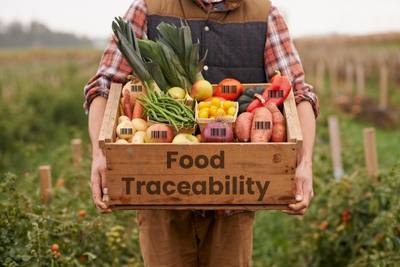
Global Trends in the Food Traceability Market: What to Expect by 2032
As we look towards 2032, the food traceability market is expected to undergo significant growth and transformation. The demand for robust traceability systems is driven by various factors, including food safety, foodborne disease reduction, and food recall efficiencies. This article will explore the multifaceted aspects of this evolving market.
What is Food Traceability?
Food traceability tracks the movement of food products and ingredients throughout the supply chain. This involves documenting and connecting every step of the supply chain, such as the production, processing, and distribution of food products and their ingredients. This helps authorities quickly find the source of contamination during a foodborne illness outbreak, leading to faster removal of affected products and reduced incidences of illnesses.
The Current State of the Food Traceability Market
Market Growth and Projections: The food traceability market is currently on a strong upward trajectory. It is anticipated to grow at a compound annual growth rate (CAGR) of 10.30% to reach USD 37.90 billion by 2029. This growth stems from the increasing demand for transparency and accountability in food sourcing and distribution to address food-related challenges, improve food safety, and reduce foodborne diseases.

Market Segmentation: The food traceability market is segmented by technology, equipment, software type, application, and end-user. Leading technologies include GPS, RFID, barcodes, and NFC, with primary end-users in food manufacturing, warehousing and transport, and retail sectors.
- The technology type segment includes Radio Frequency Identification (RFID), barcodes, infrared, biometrics, and Global Positioning Systems (GPS).
- The software segment includes Enterprise Resource Planning (ERP), friction welding, laboratory information systems, warehouse software, and Supply Chain Management (SCM) software.
- The end-user segment includes fruits and vegetables, fruit pulp and concentrates, dairy products, fish, meat, Seafood, processed food, bakery and confectionary, and others.
- The application segment includes meat and livestock, fresh produce and seeds, dairy products, beverages, etc.
Technological Innovations Driving the Market
Technological innovations are the driving force behind the evolution of the food traceability market. GPS, RFID, barcodes, and NFC are not just tools but the backbone of this market. They play a vital role in enhancing the efficiency and reliability of food traceability systems, enabling precise tracking and management of food products throughout the supply chain.
Integration with Software Solutions
These technologies seamlessly integrate with various software solutions. It facilitates data collection, storage, and exchange and improves the operational efficiency of traceability systems.

Geographical Insights
Asia-Pacific: The Fastest Growing Market: The Asia-Pacific region is predicted to be the fastest-growing market, driven by the rising demand for advanced traceability technologies such as biometrics and RFID in its emerging economies. This growth is also driven by rapid population growth, surging demand for safe and high-quality food, and changing consumption habits due to increased awareness of clean and safe F&B. Additionally, the market is influenced by regulatory trends, such as the FDA's release of the Blueprint for a New Era of Smarter Food Safety in 2020. This blueprint highlights the importance of food safety at every stage of the supply chain.
North America's Leading Position: In 2021, North America had the largest revenue share, attributed to its robust regulatory framework, advanced technological infrastructure, and high consumer awareness regarding food safety.
Market Dynamics: Drivers and Challenges
Increasing Incidences of Foodborne Diseases: A key market driver is the rising incidence of foodborne diseases and adulteration, highlighting the need for effective traceability systems to ensure food safety and quality.
Regulatory Trends Influencing the Market: Government regulations, such as the FDA’s Blueprint for a New Era of Smarter Food Safety, are significant catalysts for market growth. This emphasizes the importance of comprehensive traceability across all stages of the food supply chain, forward and backward.
Increased Awareness and Health-Conscious Consumers: The growing number of health-conscious individuals, coupled with increased purchasing power and a focus on clean and safe food, are contributing to the expansion of this market. Moreover, consumer concerns about animal welfare and environmental impacts are intensifying demands for traceability from farm to plate. This is pushing for more transparent food supply chains globally (Opara & Mazaud, 2001).

Demand in Various Fields: The rising need for food traceability applications in the packaging, logistics, retail, storage, and handling sectors is driving market growth, along with the legislative framework supporting traceability initiatives.
Challenges to Market Growth: Despite the growth drivers, the market faces various challenges. For example, high implementation costs for small operators in developing countries, concerns about data privacy and security, and consumer and manufacturer concerns about data sharing. That said, developing countries will increasingly adopt modern traceability systems to shift towards market-oriented agriculture. This shift will be supported by international collaborations and technological transfer, enabling these regions to meet global market compliance requirements more effectively (Dandage et al., 2017).
Future Predictions for 2032: By 2032, consumer demands for transparency in food sourcing will have significantly influenced global food supply chains, necessitating more powerful traceability systems. Traceability systems will expand beyond high-risk foods like seafood and meat to include a broader range of food products, including fruits and vegetables, ensuring global food safety and quality assurance. (Leal et al., 2015). The adoption of smart traceability technologies, including IoT, blockchain, and cloud computing, to ensure food safety and reduce contamination risks is set to rise. These technologies help track food through all stages of production, distribution, and sales and address data privacy and security concerns. By providing secure and efficient data management, they reassure both consumers and manufacturers about the safety and reliability of traceability systems. The food traceability market is poised for substantial growth by 2032, propelled by the increasing demand for food safety, regulatory trends, and technological advancements. This growth ensures a safer and more efficient global food supply chain and boosts trust and transparency between consumers and food producers. It opens up new opportunities for businesses to enhance their operations and for consumers to make more informed choices about the food they consume. However, challenges such as high costs for small operators in developing countries and concerns about data privacy and security must be addressed to ensure sustainable growth in the market.

How big is the food traceability market? According to IMARC Group, the global food traceability market was valued at US$20 billion in 2023 and is expected to reach US$41.4 billion by 2032, increasing at a CAGR of 8.3% from 2024 to 2032.
What are the different types of food traceability? Food traceability has two types: external and internal. External traceability tracks back (supplier traceability) and tracks forward (customer traceability). Internal traceability means a company must uphold processes to maintain and establish a direct connection between the identities of raw materials and the finished goods.
How are technological innovations impacting the food traceability market? Technological innovations such as RFID and blockchain are enhancing the efficiency and reliability of traceability systems, allowing for real-time tracking and improved data management.
What is the food traceability rule? The Food Traceability Rule is a regulation by the U.S. Food and Drug Administration (FDA) under the Food Safety Modernization Act (FSMA) to improve recordkeeping for food manufacturers, processors, packers, and holders. The rule helps with faster and more accurate recalls and outbreak investigations, reducing the impact of foodborne illness on consumers.
Islamic Services of America (ISA) is a leading USA based Halal certification and auditing organization serving companies, the community, and the Halal certification industry for nearly 50 years. Contact ISA at isa@isahalal.com or send your initial inquiry to Halal certify your products at https://isahalal.com/contact or visit the ISA website for more information at https://isahalal.com/